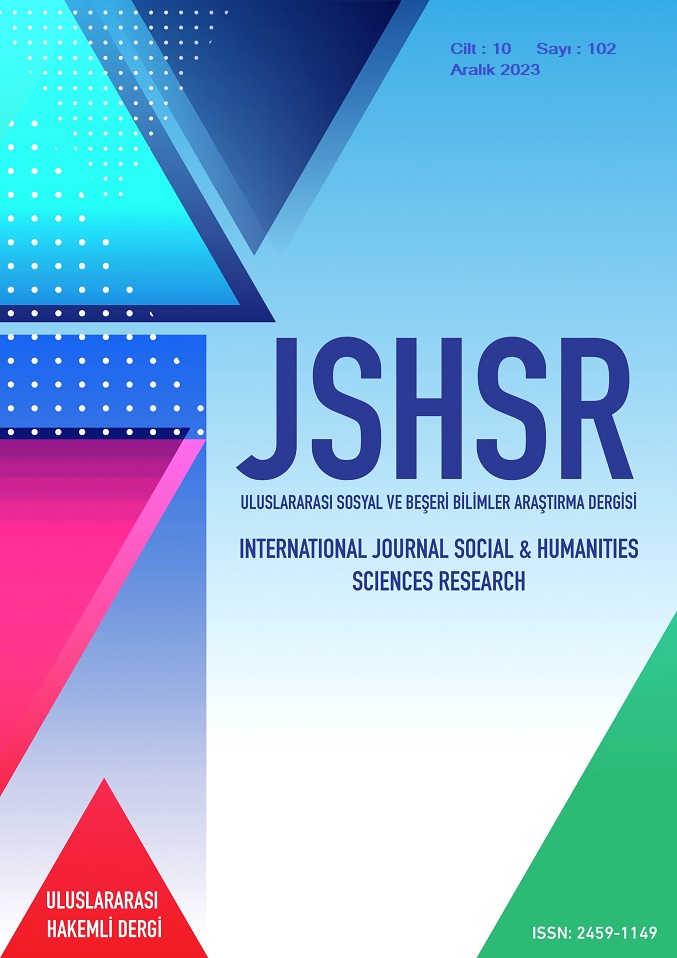The Effects of Discourse Analysis on the Formation of Spatial Emotion in the Literary-Film Ekphrasis of Anayurt Oteli
DOI:
https://doi.org/10.5281/zenodo.10431478Keywords:
ekphrasis, liminal space, interior space, hotel space, cinema space, Motherland HotelAbstract
Ekphrasis is a contemporary method of art production grounded in the written and verbal expression of visual artwork. Over time, the concept of ekphrasis has evolved to encompass the creation of new works in various art disciplines, building upon existing works by expanding their context. As an illustration of this approach, Yusuf Atılgan's literary work 'Anayurt Oteli,' published in 1973, was adapted into a film of the same name in 1987, directed by Ömer Kavur. The interior space designs, integral components of cinematic art, are analyzed in terms of the spatial discourses revealed in the literary work 'Anayurt Oteli.' Accordingly, in literary works, it is believed that spaces should harbor the potential to convey feelings of loneliness, pessimism, and tension. In cinematic works, it is observed that all spaces are designed in accordance with the liminal space concept, placing a significant emphasis on evoking a sense of loneliness. Simultaneously, it is inferred that the lighting elements of the spaces are set with low light values, the sound elements are minimized, and the colors used comprise pastel and dark tones, collectively attempting to elicit feelings of pessimism and tension.
References
Aktulum, K. (2011). Metinlerarasılık/Göstergelerarasılık. Kanguru Yayınları.
Aykın, C. (1983). Batı toplumlarında roman ve sinema ilişkileri II. Türk Dili, 383, Ekim, s. 482-503.
Atılgan, Y. (2015). Anayurt Oteli. (31. Basım). Yapı Kredi Yayınları.
Augé, M. (1995). Non-places: Introduction to an anthropology of supermodernity. Verso.
Barthes, R. (1970). L’ancienne rétorique. Communications, 16, 172-233.
Bender, J. (1972). Spenser and literary pictoralism. Princeton UP.
Boczkowska, K. (2020). Dwellers that do not belong, dwellings that no longer exist: Staging Hotel interiors and (unhomely) domesticity in experimental documentary film. Home Cultures, 17(1), 1-20. https://doi.org/10.1080/17406315.2020.1757382
Clarke, D. B., V. C. Pfannhauser, & M. A. Doel. (2009). Moving pictures/stopping places: Hotels and motels on film. Lexington Books.
Czarniawska, B., & Mazza, C. (2003). Consulting as a liminal space. Human relations, 56(3), 267-290. https://doi.org/10.1177/0018726703056003612
Clüver, C. (1997). Ekphrasis reconsidered: On verbal representations of nonverbal texts. Ulla-Britta Lagerroth, H. Lund, E. Hedling (Eds.), Interart poetics: Essays on the interrelations of the arts and media (pp. 19-33). Rodopi.
Eidt, L.M.S. (2008). Writing and filming the painting: Ekphrasis in literature and film. Rodopi.
Eli. (2013, May 14). D. W. Winnicott on transitional object and transitional space. Wordpress. https://thinkingthoughtsdotorg.wordpress.com/2013/05/14/d-w-winnicott-on-transitional-object-andtransitional-space/
Esen, Ş. K. (2015). Ömer Kavur: Sinemamızda bir ‘auteur’. Agora Kitaplığı.
Güvemli, Z. (1960). Sinema tarihi. Varlık Yayınevi.
Hagstrum, J. (1987). The sister arts. The University of Chicago Press.
Heffernan, James, A. W: (1993). Muesum of words. The University of Chicago Press.
Kayalı, K. (2022). Türk sineması: İliklerimize işlemiş, ruhumuza sinmiş bir sanat pratiği, Vakıfbank Kültür Yayınları.
Krieger, M. (1992). Ekphrasis: The illusion of the natural sign. John Hopkins University Press.
Marić, M., & Arch, M. (2011). Liminal field of architecture. International Scientific Journal Architecture and Engineering,1(1).
Mitchell, W.J.T. (2005). İkonoloji: İmaj, metin, ideoloji, (H. Arslan, Çev.) Paradigma Yayıncılık.
Ng, V. & Lim, Pey J. (2018). Tracing liminality: A multidisciplinary spatial construct. Journal of Engineering and Architecture 6(1), 76-90.
Nowell-Smith, G. (2017). The history of cinema. Oxford University Press.
Öngören, M. T. (1985). Sinema diye diye …. Kalem Yayınları.
Persin, M. (1997). Getting the picture: The ekphrastic principle in twentieth-century spanish poetry. Bucknell University Press.
Pritchard, A., & Morgan, N. (2006). Hotel Babylon? Exploring hotels as liminal sites of transition and transgression. Tourism Management, 27(5), 762-772. https://doi.org/10.1016/j.tourman.2005.05.015
Sawant, S. (2020, September 13). Space between space in Architecture: Liminal zones. Iiad. https://www.iiad.edu.in/the-circle/space-between-space-in-architecture-liminal-zones/#:~: text=Liminal%20space%20in%20architecture%20is,the%20boundary%20of%20two%20spaces.
Saydam, B. (2023, 23 Haziran). Anayurt Oteli. Avrupa Sineması. http://www.avrupasinemasi.com/ 2023/06/23/anayurt-oteli/#_ftnref3
Smith, C. (2001). The space of liminality and the space of architecture. Limen: Journal for Theory and Practice of Liminal Phenomena,1(1).
Spitzer, L. (1955). The 'ode on a grecian urn,' or content vs. metagrammar. University of OregonPress
Stephen King (2021,17 Kasım), Wikipedia. https://en.wikipedia.org/wiki/Stephen_King_bibliography
Turner, V. W. (2011). The ritual process: Structure and anti-structure. Resling.
Vidler, A. (1992). The architectural uncanny: Essays in the modern unhomely. MIT Press.
Welsh, R. (2007). The University of Chicago: Theories of media: KeyWords glossary: ekphrasis. http://humanities.uchicago.edu/faculty/mitchell/glossary2004/ekphrasis.htm, 2007.
Zukin, S. (1991). Landscapes of power: From Detroit to Disney World. University of Colifornia Press.
Downloads
Published
How to Cite
Issue
Section
License
Copyright (c) 2023 INTERNATIONAL JOURNAL OF SOCIAL HUMANITIES SCIENCES RESEARCH

This work is licensed under a Creative Commons Attribution 4.0 International License.


